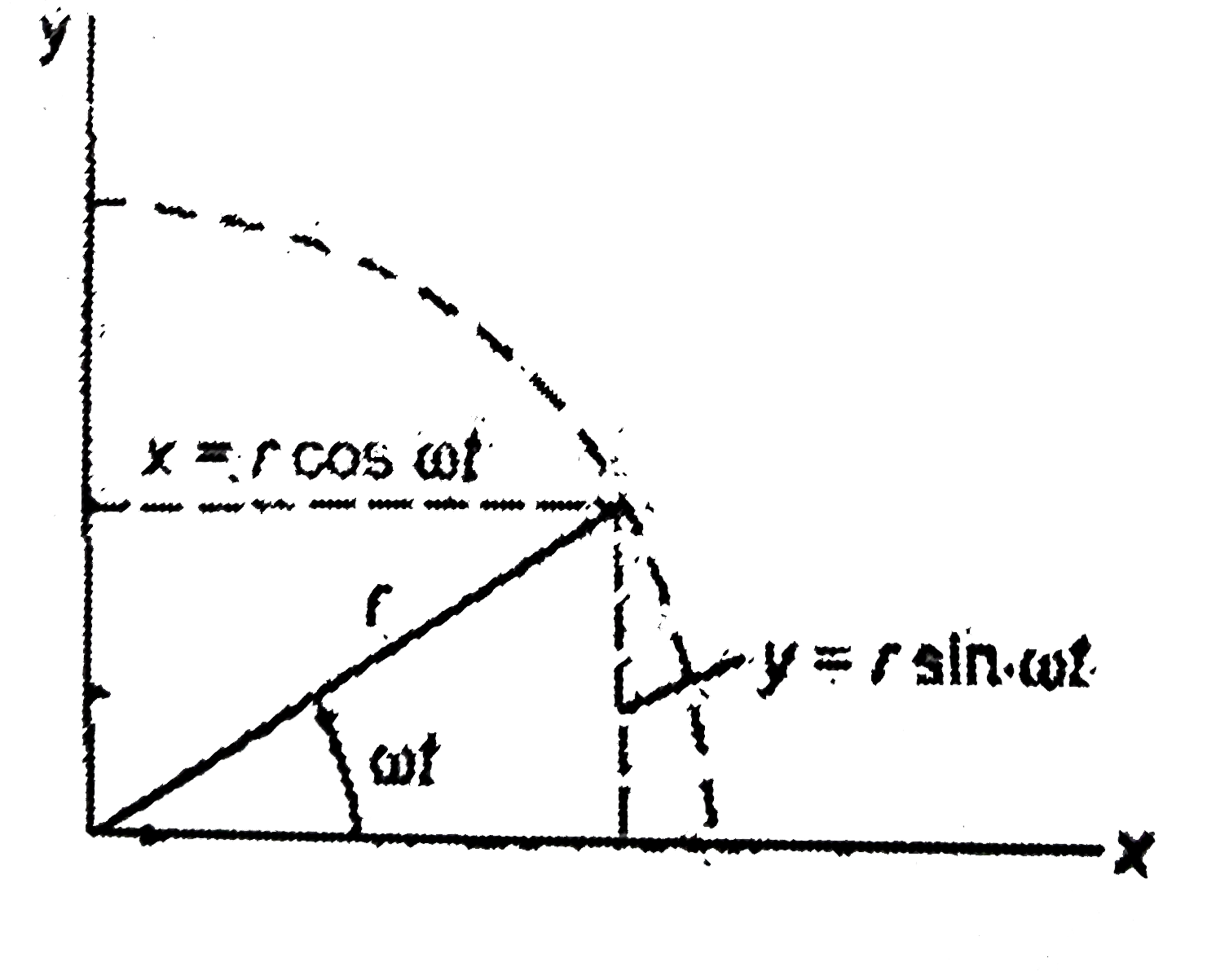A particle moves such that its momentum vector →p(t)=cosωtˆi+sinωtˆj where ω is a constant and t is time. Then which of the following statements is true for the velocity →v(t) and acceleration →a(t) of the particle :
→V is perpendicular to →P and →a is directed towards the origin
→v and →a both are parallel to →p
→v and →a both are perpendicular to →p
→v is parallel to →p and →a is perpendicular to →p
The correct Answer is:D
To solve the problem, we need to analyze the momentum vector given and derive the velocity and acceleration vectors from it. Here's a step-by-step breakdown:
Step 1: Understand the momentum vector
The momentum vector is given as:
→p(t)=cos(ωt)^i+sin(ωt)^j
where ω is a constant and t is time.
Step 2: Relate momentum to velocity
The momentum →p is related to velocity →v by the equation:
→p=m→v
From this, we can express the velocity vector as:
→v(t)=→p(t)m=1m(cos(ωt)^i+sin(ωt)^j)
Step 3: Differentiate the velocity to find acceleration
To find the acceleration →a(t), we differentiate the velocity vector with respect to time:
→a(t)=d→vdt=1mddt(cos(ωt)^i+sin(ωt)^j)
Using the chain rule:
→a(t)=1m(−ωsin(ωt)^i+ωcos(ωt)^j)
This simplifies to:
→a(t)=ωm(−sin(ωt)^i+cos(ωt)^j)
Step 4: Check the relationship between →v and →p
From the earlier steps, we have:
- →v(t)=1m(cos(ωt)^i+sin(ωt)^j)
- →p(t)=m→v(t)
This indicates that →v(t) is parallel to →p(t).
Step 5: Check the relationship between →a and →p
Now, we need to check if →a(t) is perpendicular to →p(t):
→a(t)⋅→p(t)=(−ωmsin(ωt)^i+ωmcos(ωt)^j)⋅(cos(ωt)^i+sin(ωt)^j)
Calculating the dot product:
=−ωmsin(ωt)cos(ωt)+ωmcos(ωt)sin(ωt)=0
Since the dot product is zero, →a(t) is perpendicular to →p(t).
Conclusion
From the analysis:
- →v(t) is parallel to →p(t).
- →a(t) is perpendicular to →p(t).
Thus, the correct statement is:
- Option 4: →v is parallel to →p and →a is perpendicular to →p.
The momentum vector is given as:
→p(t)=cos(ωt)^i+sin(ωt)^j
where ω is a constant and t is time.
The momentum →p is related to velocity →v by the equation:
→p=m→v
From this, we can express the velocity vector as:
→v(t)=→p(t)m=1m(cos(ωt)^i+sin(ωt)^j)
To find the acceleration →a(t), we differentiate the velocity vector with respect to time:
→a(t)=d→vdt=1mddt(cos(ωt)^i+sin(ωt)^j)
Using the chain rule:
→a(t)=1m(−ωsin(ωt)^i+ωcos(ωt)^j)
This simplifies to:
→a(t)=ωm(−sin(ωt)^i+cos(ωt)^j)
From the earlier steps, we have:
- →v(t)=1m(cos(ωt)^i+sin(ωt)^j)
- →p(t)=m→v(t)
Now, we need to check if →a(t) is perpendicular to →p(t):
→a(t)⋅→p(t)=(−ωmsin(ωt)^i+ωmcos(ωt)^j)⋅(cos(ωt)^i+sin(ωt)^j)
Calculating the dot product:
=−ωmsin(ωt)cos(ωt)+ωmcos(ωt)sin(ωt)=0
Since the dot product is zero, →a(t) is perpendicular to →p(t).
From the analysis:
- →v(t) is parallel to →p(t).
- →a(t) is perpendicular to →p(t).
- Option 4: →v is parallel to →p and →a is perpendicular to →p.
Similar Questions
Evaluate ∫t_0Asinωdt where A and omega are constants.
View SolutionThe position vector of a particle is given by →r=kcosωˆi+ksinωˆj=xˆi+yˆj, where k and ω are constants and t time. Find the angle between the position vector and the velocity vector. Also determine the trajectory of the particle.
View Solution
Knowledge Check
A particle moves so that its position vector is given by →r=cosωtˆx+sinωtˆy, where ω is a constant which of the following is true ?
AVelocity is perpendicular to →r and acceleration is directed away from the origin.BVelocity and acceleration both are perpendicular to →r.CVelocity and acceleration both are parallel to →r.DVelocity is perpendicular to →r and acceleration is directed towards the origin.A particle moves so that its position vertor is given by →r=cosωtˆx+sinωtˆy, where ω is a constant. Which of the following is true?
AVelocity and acceleration both are perpendicular to →rBVelocity and acceleration both are parallel to →rCVelocity is perpendicular to →r and
acceleration is directed to wards the originDVelocity is perpendicualr to →r and
acceleration is directed away from the originIf dispolacement x at time t is x=acosωt−bsinωt, where ω is a constant, then: acceleration=
Aω2xBωxC−ωxD−ω2x
A particle moves so that its position vector varies with time as →r=Acosωtˆi+Asinωtˆj. If d→rdt gives instantaneous velocity. Find the initial velocity of particle.
View SolutionThe vectors →A is given by →A=tˆi−(sinπt)ˆj+t2ˆk where t is time. Then which of the following is
View SolutionConsider a particle moving in the x−y plane according to r=r(cosωtˆi+sinωtˆj), where r and ω are constants. Find the trajectory, the velocity, and the acceleration.

View SolutionA particle moves so that its position vector varies with time as →r=Acosωtˆi+Asinωthai(j). The initial velocity of the particel the particle is
View SolutionThe position vector of a particle is →r=acosωti+asinωtj, the velocity of the particle is
View Solution

